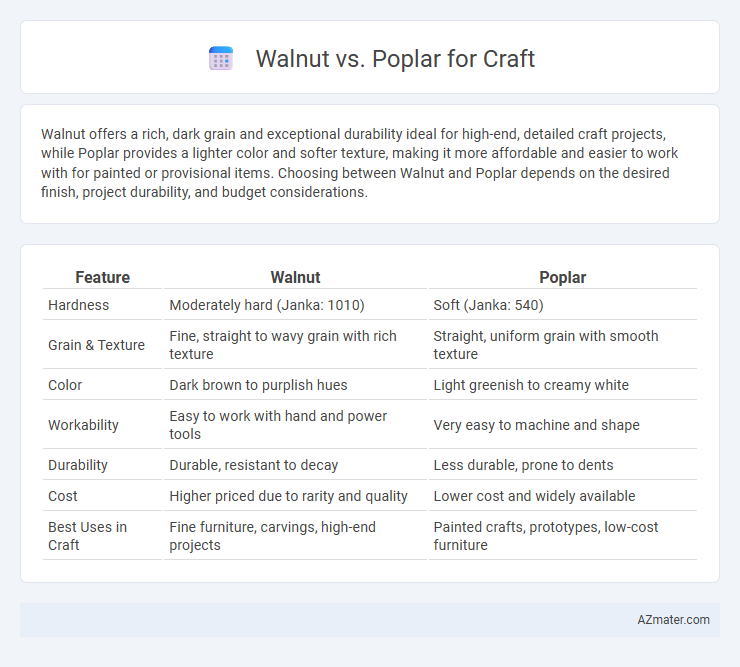Walnut offers a rich, dark grain and exceptional durability ideal for high-end, detailed craft projects, while Poplar provides a lighter color and softer texture, making it more affordable and easier to work with for painted or provisional items. Choosing between Walnut and Poplar depends on the desired finish, project durability, and budget considerations.
Table of Comparison
| Feature | Walnut | Poplar |
|---|---|---|
| Hardness | Moderately hard (Janka: 1010) | Soft (Janka: 540) |
| Grain & Texture | Fine, straight to wavy grain with rich texture | Straight, uniform grain with smooth texture |
| Color | Dark brown to purplish hues | Light greenish to creamy white |
| Workability | Easy to work with hand and power tools | Very easy to machine and shape |
| Durability | Durable, resistant to decay | Less durable, prone to dents |
| Cost | Higher priced due to rarity and quality | Lower cost and widely available |
| Best Uses in Craft | Fine furniture, carvings, high-end projects | Painted crafts, prototypes, low-cost furniture |
Overview: Walnut vs Poplar
Walnut offers a rich, dark brown hue with tight grain patterns, making it ideal for high-end woodworking and fine furniture, while poplar features a lighter, pale yellow to greenish color with a straight, uniform grain, favored for its affordability and ease of painting. Walnut is denser and more durable, providing superior strength and resistance to wear, contrasted by poplar's softer texture, which is easier to machine but less resilient over time. The choice between walnut and poplar depends on project aesthetics and functional requirements, with walnut suited for luxury crafts and poplar preferred for budget-conscious or painted projects.
Physical Characteristics Compared
Walnut wood exhibits a rich, dark brown color with a straight grain and moderate texture, making it highly prized for its durability and fine finish in craft projects. Poplar wood features a lighter, creamy to greenish hue with a softer, more uniform grain, offering easier workability but less resistance to dents and scratches compared to walnut. The density of walnut measures around 610 kg/m3, significantly higher than poplar's approximate 450 kg/m3, impacting the strength and longevity of crafted items.
Color and Grain Patterns
Walnut features rich, dark brown hues with occasional purplish tones and striking, straight to wavy grain patterns that provide a luxurious, high-end look for crafts. Poplar offers a lighter, creamy white to pale yellow color with subtle green or brown streaks, and its uniform, straight grain creates a smooth, consistent surface ideal for painting or staining. The distinct color and detailed grain of walnut make it preferable for visible, decorative projects, while poplar's milder appearance suits versatile, budget-friendly crafts.
Workability and Ease of Use
Walnut offers exceptional workability due to its fine grain and moderate hardness, making it easy to shape, carve, and finish with smooth results ideal for detailed craft projects. Poplar, being softer and less dense, provides excellent ease of use for beginners by allowing quicker cutting and sanding, though it may lack the durability required for more intricate or high-wear crafts. Both woods work well with hand tools and machines, but walnut's superior stability and natural resistance to splitting give it an edge in professional-quality craftsmanship.
Durability and Strength
Walnut wood offers superior durability and strength, making it ideal for long-lasting craft projects requiring robust materials. Poplar, while easier to work with and more affordable, has lower density and strength, making it less resistant to wear and impact. Crafts that prioritize sturdiness and longevity benefit more from walnut than from poplar.
Cost and Availability
Walnut is a premium hardwood known for its rich color and durability, making it more expensive and less readily available than poplar. Poplar is widely accessible, affordable, and easy to work with, making it a popular choice for budget-conscious craftspeople. The lower cost and higher availability of poplar often outweigh walnut's aesthetic advantages for many craft projects.
Finishing and Staining Qualities
Walnut offers a rich, dark finish that stains evenly and enhances its natural grain, making it ideal for high-end crafts requiring deep, luxurious tones. Poplar features a pale, uniform surface that accepts paint and stains well but may require pre-staining treatment to avoid blotchiness, providing versatility for various decorative finishes. Both woods respond well to sanding and sealing, but walnut's superior oil content results in a smoother, more polished final appearance.
Best Craft Applications for Walnut
Walnut wood is prized for its rich, dark color and fine grain, making it ideal for high-end woodworking projects like furniture, cabinetry, and intricate inlays. Its durability and workability allow craftsmen to create detailed carvings, turned objects, and musical instruments with a smooth finish. Walnut's natural strength and aesthetic appeal also make it a top choice for luxury craft applications requiring both beauty and resilience.
Best Craft Applications for Poplar
Poplar wood excels in craft applications requiring easy workability, making it ideal for painted projects, children's toys, and prototypes due to its smooth grain and lightweight nature. Its affordability and consistent texture enable precise cutting, sanding, and finishing, perfect for intricate carvings and detailed inlays. While less durable than walnut, poplar is favored for craft items that benefit from its versatility and ability to hold paint and stains evenly.
Choosing the Right Wood for Your Project
Walnut offers rich color, durability, and a fine grain ideal for high-end furniture and detailed craftwork, while poplar provides a softer, lightweight, and more affordable option suitable for painted projects and prototypes. Consider walnut for projects requiring strength and visual appeal, especially when natural wood grain is showcased, and poplar for versatile, easy-to-work-with wood when cost and paintability are priorities. Evaluating the intended use, desired finish, and budget ensures the right wood choice for optimal craft outcomes.

Infographic: Walnut vs Poplar for Craft
 azmater.com
azmater.com